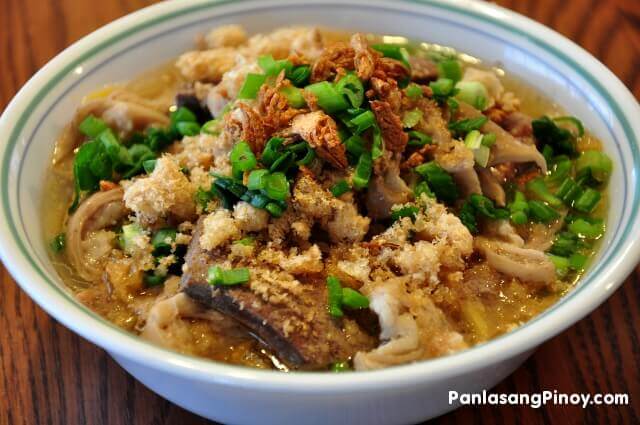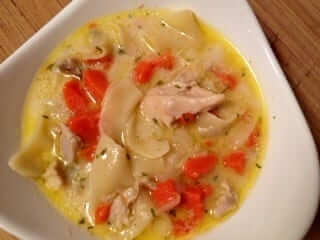Batchoy Recipe
Batchoy is a soup dish composed of sliced pork, pig’s innards, and miki noodles. This dish originated from the district of La Paz in Iloilo City in the island of Panay.
This post may contain affiliate links. Please read our disclosure policy.
The name “Batchoy” is believed to come from the Hokkien term “bah-chúi,” which means “meat dish,” reflecting the dish’s meat-centric ingredients. Over time, this traditional Batchoy recipe has evolved to include local variations and has become a beloved staple in Filipino cuisine!

When rainy weather sets in, there’s nothing quite like a comforting bowl of soup to warm you up, and Batchoy is the perfect choice. You can often find this in carinderias (local eateries). If you’re craving a bowl of traditional Batchoy but want to try making it at home, you’ve come to the right place. In this recipe, I’ll guide you through the steps to create this delicious and satisfying dish from scratch, so you can enjoy the cozy, heartwarming flavors anytime you like.
How To Cook Batchoy
preparing the flavorful batchoy broth base
Start by boiling 7 cups of water in a cooking pot. Once boiling, add 1.5 teaspoons of salt, 2 teaspoons of sugar, 1 teaspoon of onion powder, 1/2 teaspoon of ground black pepper, and 1 teaspoon of shrimp paste (optional). Cook this mixture for one minute to allow the flavors to blend, creating a rich base for the Batchoy.
Cooking the Pork for Tenderness
Next, add 1 pound of pork to the broth. Cook the pork until it becomes tender, which will take about 30 to 45 minutes. This step is essential, as the pork provides the main protein and contributes a rich flavor to the Batchoy.
Adding Intestines and Liver
After the pork is tender, introduce 1 pound of cleaned and sliced pig intestines and 1/4 pound of sliced pig liver into the pot. Cook these ingredients for an additional 6 to 10 minutes. This addition enhances the dish with textures and flavors that are characteristic of traditional Batchoy.
Slicing the Cooked Meats
Once cooked, remove the pork, liver, and intestines from the broth and set them aside. Slice the pork into thin strips to prepare it for serving. This makes it easier to enjoy the rich flavors in each bite of the Batchoy.
Arranging Noodles and Toppings
In a single serving bowl, arrange 1 pound of pre-boiled miki noodles. Place the sliced pork, liver, and intestines on top of the noodles. This arrangement sets the stage for the final assembly of your Batchoy.
Completing the Dish with Broth and Garnishes
Pour the hot broth over the noodles and meat, ensuring everything is well-covered. Finally, garnish the dish with 1 cup of crushed pork cracklings (chicharon), 3 tablespoons of chopped spring onions, and 1/4 cup of toasted garlic. These toppings add texture, flavor, and visual appeal.
Serve the Batchoy hot, inviting everyone to enjoy this comforting and flavorful noodle soup that brings together a delightful blend of ingredients and textures.
Origin Of Batchoy
Traditional Batchoy is a soup dish made with sliced pork, pig’s innards, and miki noodles. This dish originated from the district of La Paz in Iloilo City, located on the island of Panay, Philippines. Over the years, this traditional Batchoy recipe has gained popularity and become a favorite soup dish alongside beef mami, beef pares, and bulalo. The miki noodles used in this recipe are fresh egg noodles, commonly used in soup dishes. Since the noodles are fresh, they require minimal cooking time; sometimes, pouring hot broth over them is enough to cook them.
Batchoy Ingredients
The shrimp paste I used here is optional, but the rest of the ingredients below are essential for giving your Batchoy an authentic, traditional Filipino flavor.
Main Ingredients
- 7 cups water – Serves as the base for this comforting soup.
- 1 lb miki noodles boiled for 1 minute and drained – The traditional Batchoy recipe uses fresh egg noodles, but some variations, such as Batchoy Tagalog, use miswa (or misua). Feel free to use whichever type of noodle you prefer!
- 1 lb pork – Cooked until tender in the broth, this provides the main protein and a rich, meaty flavor. It should be cut into bite-sized pieces or thin slices.
- 1 lb pig’s intestines; cleaned boiled, and sliced – Pig’s intestines add a unique texture and flavor to the dish. Clean the pig’s intestines thoroughly, boil them to remove any impurities, and then slice them into small pieces.
- 1/4 lb pig liver sliced into strips – Pig liver adds a distinctive taste and extra richness to the dish. Slice the pig liver into strips for easy addition into the soup.
Seasonings And Garnishes
- 1 1/2 teaspoons salt – Salt enhances the overall flavor of the dish, balancing the richness of the meat and soup.
- 1/2 teaspoon ground black pepper – Ground black pepper adds a mild heat and depth of flavor, complementing the other seasonings.
- 2 teaspoons sugar – Sugar helps balance the savory and salty flavors in the dish, adding a slight sweetness to the broth.
- 1 teaspoon shimp paste bagoong or guinamus (optional) – Shrimp paste adds a strong umami flavor and complexity to the broth. It is optional and you omit it for a milder taste.
- 1 teaspoon onion powder – Adds a subtle onion flavor to the broth for extra depth to this traditional noodle soup.
- 1 cup pork cracklings chicharon, crushed – Pork cracklings add a crispy texture and additional flavor. You can typically crush and use this as a topping to add crunchiness.
- 3 tablespoons spring onion chopped – Spring onions provide a fresh, crisp flavor and a burst of color. Add the spring onions as a garnish to enhance the dish’s presentation and taste.
- 1/4 cup toasted garlic – Toasted garlic adds a rich, nutty flavor and a crunchy texture. Use it as a topping to give the dish extra depth and aroma, as you would with all mami noodle soup dishes!
How Do Filipinos Enjoy Traditional Batchoy
Filipinos enjoy traditional Batchoy in various delightful ways that enhance its rich, savory flavor. Often, a splash of patis (fish sauce) is added to bring out more depth and umami. A squeeze of fresh lime adds a tangy brightness that balances the dish. For those who prefer extra heat, you can put extra chili flakes to spice things up. Some also enjoy Batchoy with a side of warm, crusty bread, perfect for soaking up the flavorful broth!
Aside from the pork innards and meat, there is a variation of Batchoy, specifically Batchoy Tagalog, which uses coagulated pork blood slices and adds ginger to remove the “lansa” (fishy taste) of the blood. You can use this version if you prefer, but in this traditional Batchoy recipe, we do not use pork blood.
Traditional Batchoy Recipe
This traditional Batchoy recipe calls for the use of shrimp paste or guinamus (or guinamos). Unlike regular shrimp paste or bagoong, this traditional noodle recipe uses shrimp paste sold in small blocks. You mix the blocks with water and boil them to extract their flavor. After boiling, strain the mixture and add the resulting liquid to the broth or “caldo.” If you can’t find this specific type of guinamus, you can use regular shrimp paste, as I did!
What Is La Paz Batchoy
La Paz Batchoy is a familiar term commonly associated with Filipino cup noodles as a flavor, reflecting its popularity and cultural significance. The name “La Paz Batchoy” originates from the La Paz district in Iloilo City on the island of Panay in the Philippines. This is the place where this hearty noodle soup first became renowned. Our traditional Batchoy recipe is actually La Paz Batchoy. But since La Paz, Iloilo, holds the crown for that specific style, we will simply refer to it as Batchoy. This classic dish remains a beloved staple, offering a rich, comforting taste that connects deeply with its roots and the Filipino palate!
Did you make this? If you snap a photo, please be sure tag us on Instagram at @panlasangpinoy or hashtag #panlasangpinoy so we can see your creations!

Batchoy Recipe
Ingredients
- 1 lb miki noodles boiled for 1 minute and drained
- 1 lb pork
- 1 lb pig intestine boiled, and sliced
- 1/4 lb pork liver sliced into strips
- 1 1/2 teaspoons salt
- 1/2 teaspoon ground black pepper
- 2 teaspoons sugar
- 1 teaspoon shrimp paste bagoong or guinamus * optional
- 1 teaspoon onion powder
- 1 cup pork cracklings chicharon, crushed
- 3 tablespoons spring onion chopped
- 1/4 cup toasted garlic
- 7 cups water
Instructions
- Boil water in a cooking pot.7 cups water
- Put-in salt, sugar, onion powder, ground black pepper, and shrimp paste. Cook for a minute.1 1/2 teaspoons salt, 1/2 teaspoon ground black pepper, 2 teaspoons sugar, 1 teaspoon onion powder, 1 teaspoon shrimp paste
- Add the pork and cook until tender (about 30 to 45 minutes)1 lb pork
- Put-in the intestines and liver, and then cook for 6 to 10 minutes.1 lb pig intestine, 1/4 lb pork liver
- Remove the pork, liver, and intestine from the broth (caldo). Set aside.
- Slice the pork into strips.
- Arranged the cooked miki noodles in a single serving bowl.1 lb miki noodles
- Place the strips of pork, liver, and intestine on top of the miki noodles.
- Pour the broth in the bowl, and then garnish with pork cracklings (chicharon), spring onion, and toasted garlic.3 tablespoons spring onion, 1/4 cup toasted garlic, 1 cup pork cracklings
- Serve hot. Share and enjoy!




Ley says
Boil it with alot of pork bones , that will give more flavors. Toast a garlic too to garnish and fresh green onion. Please dont forget eggs. It could be boiled eggs or raw eggs before you put the boiling broth over it. And pair it with puto.
elilla m. mascunana says
hi
B 4 migrating to canada, we used to live in manila, but my husband is originally fr bacolod so everytime we visit there -- we make is sure that we hv to hv BACHOY.
since i found the recipe fr ur website, i will try to cook/prepare bachoy. is it necessary to hv intestines as one of the ingredients. pls advise. thank you.
prim3-rib88 says
kuya anu pde ipalit sa intestine ksi wla d2 nyan. thx
eins says
i’m half-ilongga and i never miss la paz batchoy when i’m in iloilo. i like it with fresh egg, added right before they pour in the broth. Though i know some people don’t like raw eggs, the hot broth actually cooks it and makes a huge difference, adds creaminess and flavor to the broth. Thank you for sharing this dish.
april says
now i want to cook it…
The Beancounter says
Nowadays, I have to settle for lucky me’s bastardized version… Thanks for the recipe vanjom!
Peter says
This is my all time fave soup! Hmm, thank you for posting this. Id like to try your recipe anytime soon.
belinda says
i havent’ taste this for a long time, can i not put shrimp paste, pork innards and use chicken instead of pork? thanks!
LK says
Question here.
This is my favorite and haven’t had it for many years.
The miki noodle looks like Pancit Canton. Can I replace the noodle with PnacanCanton?
I don’t think we have miki noodle available in our area.
Or any other dey Chinese yellow noodles?
Appreciate your response 🙂
sweetz says
miki po is fresh egg noodles, you can also use bihon (rice sticks), misua(wheat flour noodles) or sotanghon (vermicelli), the only thing is it needs to be cooked first, unlike the fresh egg noodles you can directly put the broth. hope this helps
Donna Marie says
Wow, one of my favorite dishes. Thanks for sharing. Your recipe is far more interesting than mine. 😀